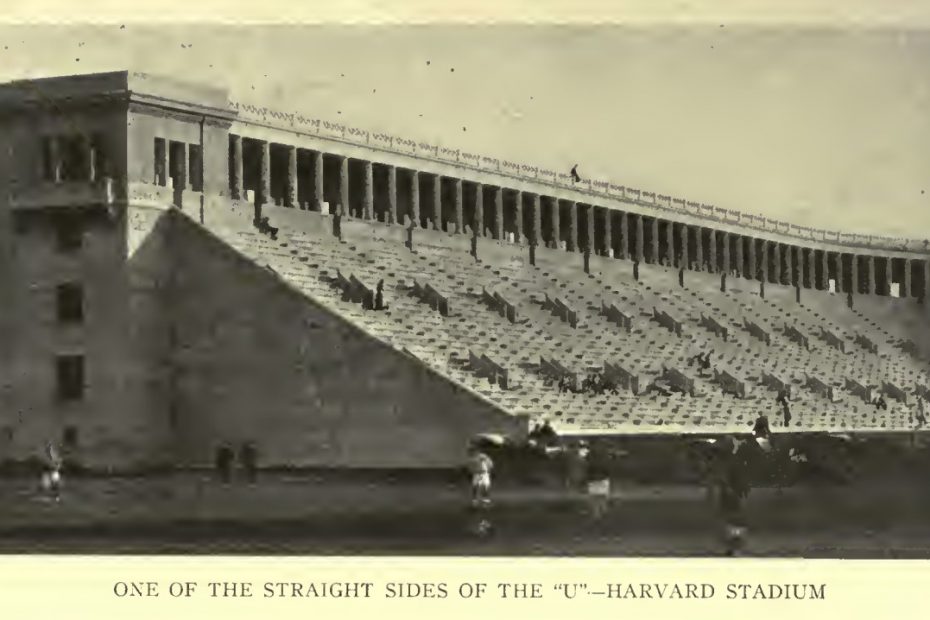The Birth of the Stadium
Journey back to the 19th- and early 20th-centuries as I uncover a captivating chapter of our nation’s recreational history – the birth of the American football stadium. Uniquely American, these architectural marvels emerged on college campuses at a time when sports and leisure began to carve out their place in our collective consciousness. These historic stadiums rose from the shared vision of architects, engineers, and college athletic departments whose innovative ideas created today’s architectural treasures. This multipart series identifies, documents, and recognizes America’s most historically and architecturally significant vintage football stadiums. Together, let’s ignite a renewed passion for vintage football stadium architecture, with a special focus on those structures that stood proudly before 1945.
Copyright © Jennifer Kenny, 2023
AMERICAN FOOTBALL BEGUN ON 19th-CENTURY COLLEGE CAMPUS GRIDIRONS
American football is a 19th-century invention. Its beginnings stem from informal games played at east coast, largely elite universities. The game borrows from both soccer and rugby, and evolved into today’s sport after much trial and error.
Boston’s secondary schools initiated organized football in 1860,[i] yet intercollegiate football escalated its popularity. On November 6, 1869, Princeton University and Rutgers University met in the first intercollegiate American football game in New Brunswick, New Jersey.[ii] Through the late 1870s and 1880s, more and more schools began intercollegiate play, particularly throughout the northeast. In 1877, Washington and Lee University and Virginia Military Institute, both of Lexington, VA, played the first game in the southern U.S.[iii] When the University of Michigan and Racine College (WI) played on May 30, 1879 in Chicago at White Stockings Field, intercollegiate football was introduced for the first time to the Midwest.[iv] Furthermore, intercollegiate football arrived on the West Coast when Stanford University played the University of California in San Francisco in 1892.[v]
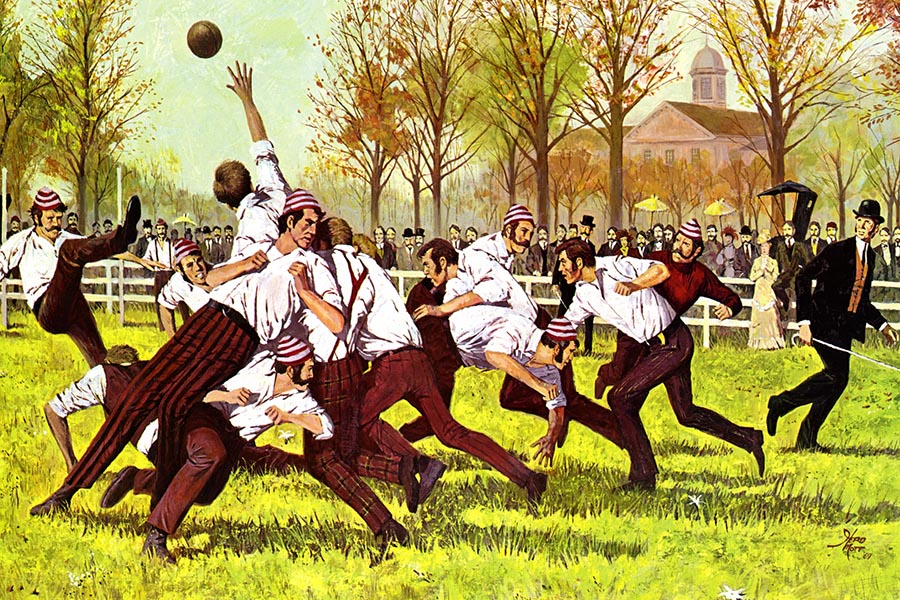
In the early days of American college football, teams played without many rules and without much structure. Many games were played without coaches and, instead, led by captains. Without much oversight in the sport, violent play almost put an end to football in the 1890s through the 1910s.
The establishment of collegiate rules committees (later known as conferences) helped. These committees worked to eliminate the game’s dangers. In 1894, the first rules committee consisted of the earliest football playing schools, then known as the “Big Four:” Harvard, Yale, Princeton and Penn.[vi] It took many more years before this committee could agree upon set football rules. Soon other colleges began to organize to reform the game. When the University presidents of Chicago, Illinois, Michigan, Minnesota, Northwestern, Purdue and Wisconsin met in 1895, they began legislating the sport and formed the Western Intercollegiate League, later known as the Big Ten Conference.[vii]
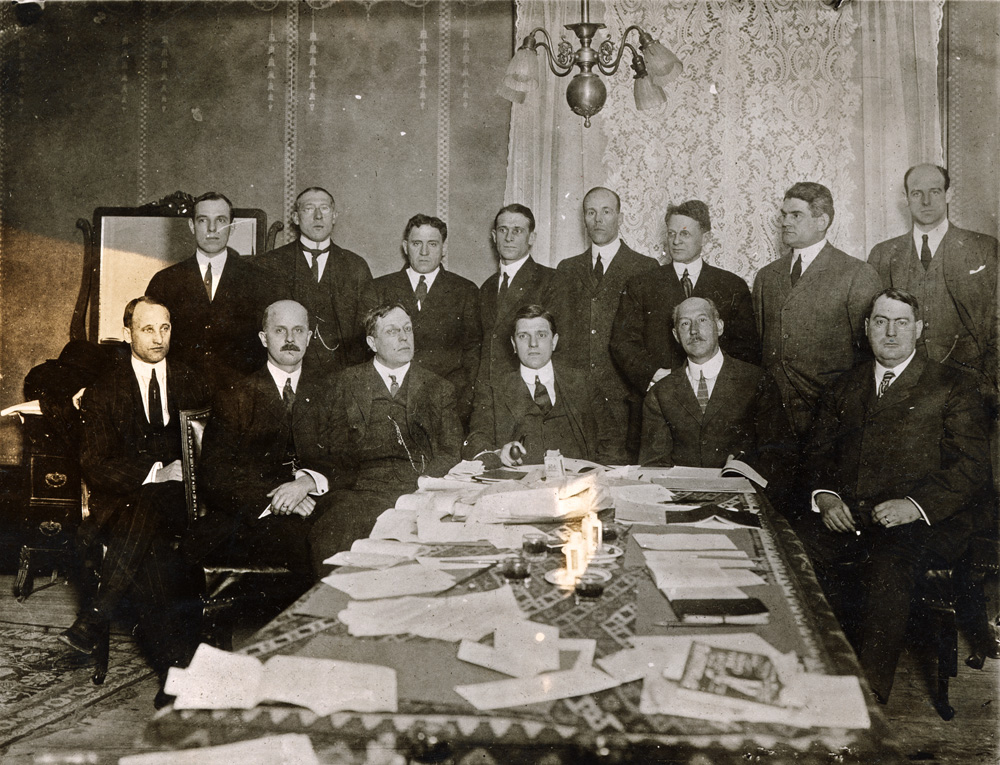
After numerous injuries and deaths, President Theodore Roosevelt intervened in 1905 to stop the violent play amongst college football teams. At that time, some colleges abandoned the sport temporarily, while others dropped football entirely. Soon a conference of colleges came together to form the American Intercollegiate Football Rules Committee for all athletics, to reduce hazardous play and ultimately saving football. In 1910, this committee changed its name to the National Collegiate Athletic Association (NCAA).[viii] According to Allison Danzig in The History of American Football, the legalization of the forward pass within this rules committee made a far reaching change for the better in early 1906. He writes:
“But football definitely was on its way from a prosaic test of brawn, of pushing, pulling, and trampling, to a test of skill and intelligence, as well as of physical powers, in carrying out coordinated maneuvers cleverly designed and painstakingly perfected.”[ix]
Football’s expert leaders, coaches, and formulators, including the “father of football” Walter Camp, Amos Alonzo Stagg, Glenn “Pop” Warner, amongst many others, set the sport on a path to today’s modern game. As football experienced an evolutionary process in the late 19th– and early 20th-century, so too did the places and outdoor spaces created to play the game.
EARLY SPACES TO PLAY FOOTBALL
As American football evolved as an organized sport in the last decades of the 19th-century, so did the need for a defined space for competition. Since college football predates American professional football by over fifty years, college campuses are home to American football’s earliest and most historic home fields and stadiums.
In the early years, college football teams played on open, designated home fields or grounds secured by the University. These early playing spaces were typically basic playing fields with no permanent seating. Fans and spectators would stand on the sidelines of the grid iron, a term for the rectangular playing field marked with yard-lines, to watch football games.
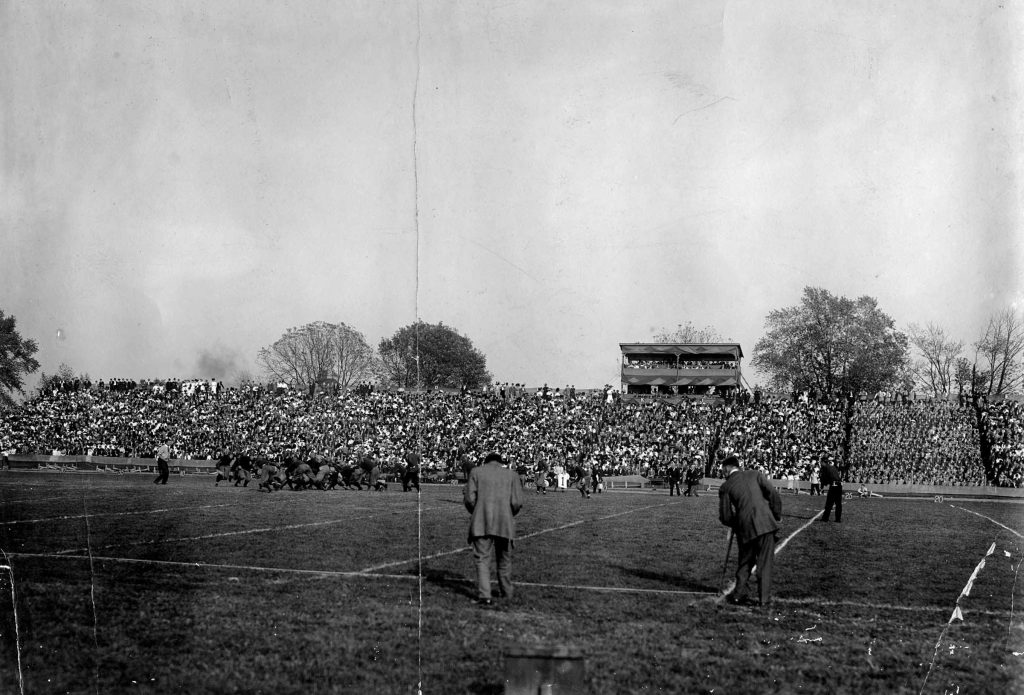
Beginning in mid-1890s, the home field began to be replaced what is considered a small scale football stadium. These early stadiums were mostly enclosed playing fields with limited seating. Surrounded by a fence or other wall barrier, the small scale stadium featured wood seating in one-tiered, detached grandstands or bleachers placed along the sideline of a playing field or gridiron. Often, fans considered wooden stands unsafe, as most were unsteady and unable to withstand crowds. They also were prone to fires. At this pivotal moment in football history, universities began exploring solutions in both design and materials for hosting athletic events on campus.
COLLEGE FOOTBALL’S FIRST STADIUM: FRANKLIN FIELD built 1895, rebuilt 1922, 1925
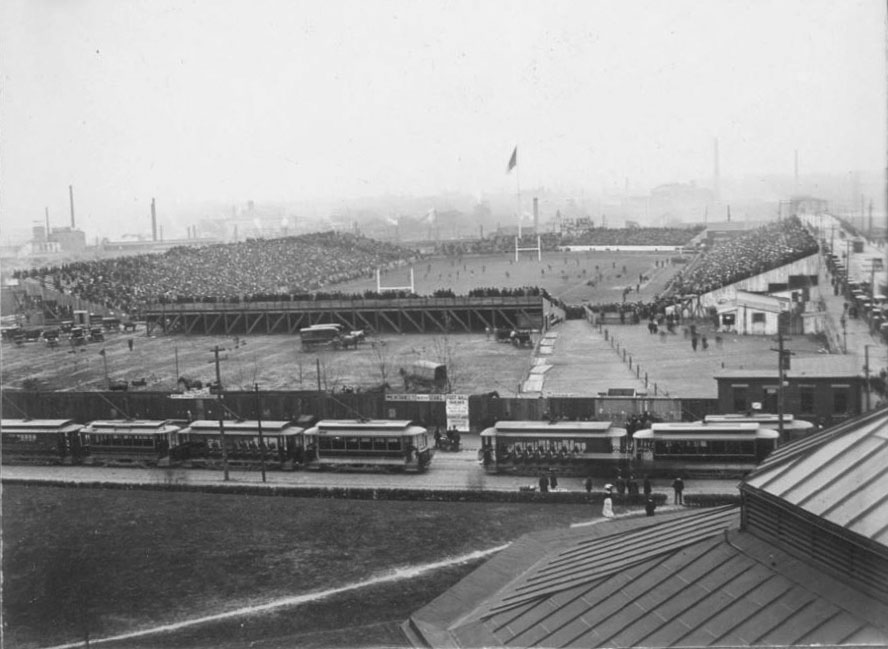
The University of Pennsylvania constructed the very first college football stadium in the United States. Franklin Field, home to the University of Pennsylvania Quakers and the Penn Relays, was opened in Philadelphia, PA, on April 20, 1895 with a capacity of 20,000.[xi] Penn initially built Franklin Field as a one-side, one-tiered stadium with wooden stands. The design was quite small compared with those college stadiums that followed. Named for Benjamin Franklin, the founder of the University of Pennsylvania, the country’s first football stadium was significantly altered by the mid-1920s. Today’s Franklin Field has lost its historic 1894-95 architectural appearance and integrity due to two major, piecemeal construction projects: the lower seating tier in 1922 and upper seating tier in 1925. Sadly, Franklin Field as it exists today, does not represent what was once the first football stadium in the U.S.
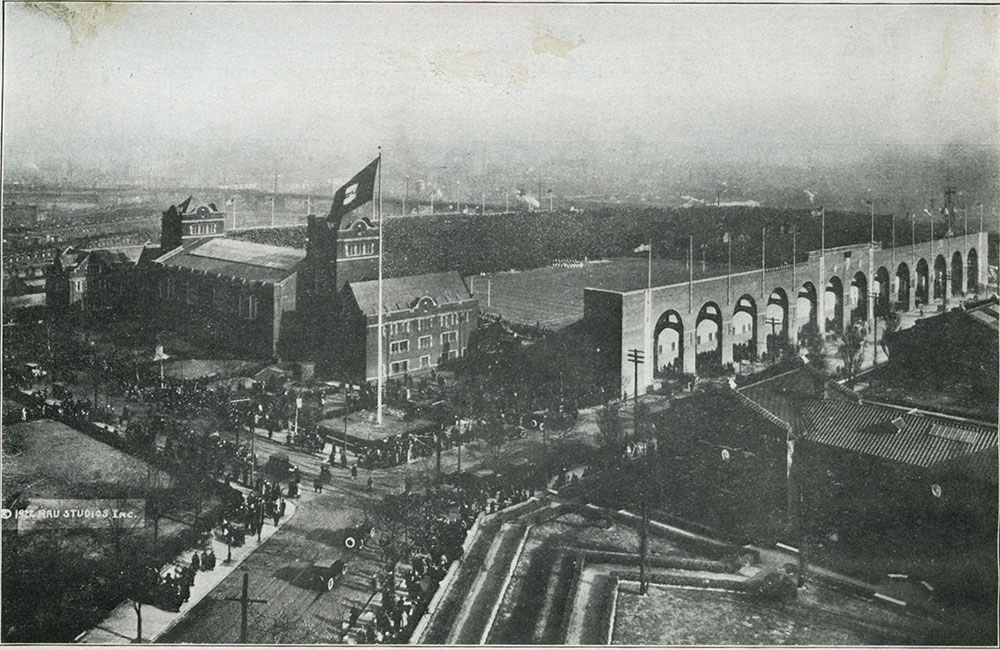
In May 1922, the Penn demolished the 1895 stadium stands.[xii] Constructed in its place was a new, larger, one-tiered brick, U-shaped stadium with steel and concrete stands from plans by the local architectural firm of Day and Klauder. This muleshoe stadium, modeled after the stadium at Olympia, Greece, has two straight sides and one semicircular end. The muleshoe is anchored on the west by Weightman Hall, constructed in 1902 as a fieldhouse. Day and Klauder of Philadelphia also planned the additions and alterations in 1922 to Weightman Hall. By 1925, the University discussed expanding the stadium to a two-tiered design to keep up with other large scale stadiums of the era. Once again, Penn hired Day and Clauder to design Franklin Field’s upper deck stands, making the stadium a two decked muleshoe. Photos show the change from a brick arcade to a two level arcade on its brick exterior. As of 2023, Franklin Field is not listed on the National Register of Historic Places, nor is it a National Historic Landmark.
ANCIENT MODELS FOR STADIUM DESIGN
As college football grew in popularity in the first decades of the 20th-century, so did the desire for both large and small schools to have a permanent, dedicated home for the sport. College football coaches and athletic staffs often championed new stadiums once the sport outgrew playing fields and early campus homes to the game. In a setting of higher learning, it is not surprising that college administrators sought academic models for the football stadium. For this reason, American football stadium architecture is directly derived from ancient Greek amphitheaters and the famed Roman Colosseum.
In the fascinating world of ancient architecture, the Greeks were true visionaries, and their creation of the amphitheater in the 6th-century BCE stands as a testament to their ingenuity. The amphitheater is legendary, with its elliptical, open-air design that boasts ascending tiers of seats surrounding a flat arena. What truly sets the Greek amphitheaters apart is their meticulous placement within the natural landscape. These masterpieces were strategically nestled into hillsides, offering spectators not only an intimate view of the performances but also breathtaking vistas of the surrounding scenery. It was a marriage of art, nature, and entertainment that has left a lasting impression on history. Not surprisingly, universities embraced the Greek amphitheater, where epic theater and other spectacles unfolded, as an inspirational model for the football stadium.
Following in the footsteps of the Greeks, the Roman Colosseum emerged on the scene, a monumental elliptical structure dating back to 72 or 75 AC. Its elliptical shape, innovative use of arches, and ingenious spectator entry and seating arrangements went on to influence the design of modern-day football stadiums. Standing proudly as one of the Wonders of the World, the Colosseum is widely regarded by experts as the pinnacle of architectural and engineering achievement during the Roman Empire. Universities also looked to the Roman Colosseum as an inspirational model for stadium design.
AMERICAN FOOTBALL STADIUMS OF THE 1900s and 1910s
Using the amphitheater and Colosseum models, architects and builders shaped the American football stadium in the first two decades of the 20th-century. The stadium, as a new recreational structure, filled the need for a dedicated space to house games, contests or exhibitions and provide seating for crowds of spectators. American football stadiums vary in their size, shape, details, and purposes.
HARVARD STADIUM: EARLIEST REINFORCED CONCRETE FOOTBALL STADIUM REMAINING IN THE U.S.
Still standing today from the earliest period of college footbal stadium development in the United States is Harvard Stadium. Harvard University built its football stadium in Boston in 1903 and one of the first in the United States to utilize monolithic, reinforced concrete construction. The University of California built the first concrete stadium in the United States in 1903, modeled after the Theatre of Dionysius in Athens, Greece.[xiii] However, California Field was replaced with a new stadium in 1922.
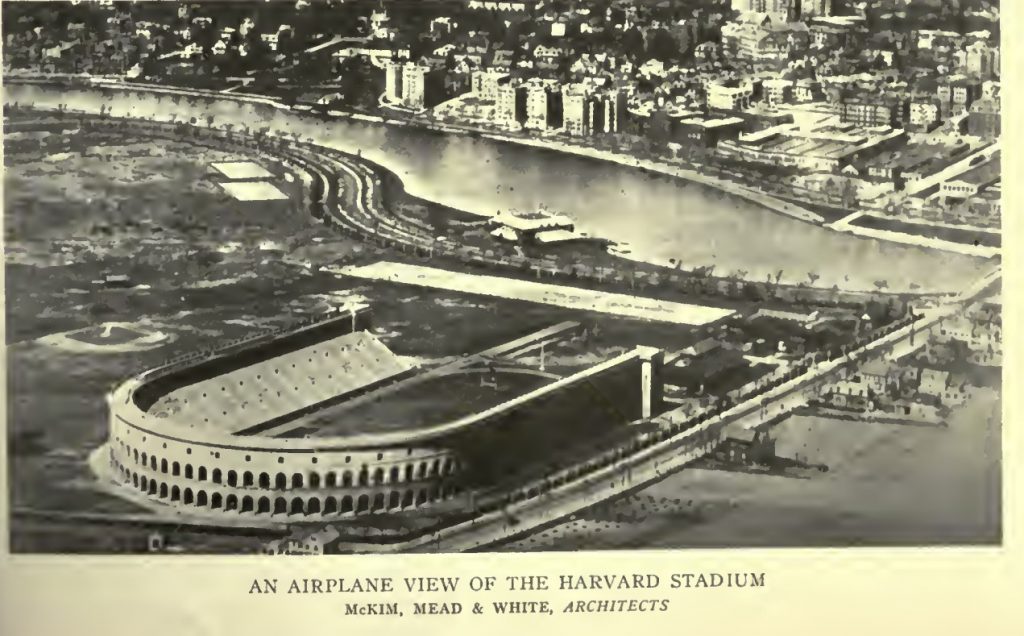
Designed to resemble the Olympic Panathenaic Stadium in Athens, Greece, Harvard Stadium is a U-shaped, muleshoe design. Muleshoe plans are a stadium layout with parallel, straight sides that bend into a closed end that is built on the arc of a true circle. The stadium’s other end is left open. Harvard Stadium’s playing field is a standard football gridiron surrounded by a track.
A team of architects and engineers designed Harvard Stadium: H. Langford Warren, Harvard’s first professor of architecture; Lewis Johnson, Harvard professor of civil engineering; Charles F. McKim of McKim, Mead and White, architects; and George Bruno de Gersdorff, architect.[xiv] “It has been said the McKim added the “Classical Dressing” to the stadium’s innovative reinforced concrete engineering.[xv] Harvard Stadium’s exterior wall was inspired by Greek stadia and Roman circuses. The brick wall features two tiers of Roman arches and piers, separated by a molded beltcourse. Above the second level is a parapet with a massive cornice of simple square openings over alternate arches below. A great interior colonnade runs along the top of the stadium, becoming inspiration for later stadium designs. The colonnade, parapet and its concrete roof were added in 1910, as were the two square pavilions at the ends of the U. Harvard Stadium retains much of its original design and architectural integrity.
When built, Harvard Stadium’s capacity was about 24,000 fans. Between 1929 and 1952, the open end of the horseshoe plan that once opened out to the river, was enclosed with seating. Today, the end is once again open allowing for temporary stands when necessary. Harvard Stadium was an inspirational prototype for stadium design, and remains America’s oldest stadium in use. Today, it is designated National Historic Landmark.
YALE BOWL – AMERICA’S FIRST BOWL FOOTBALL STADIUM
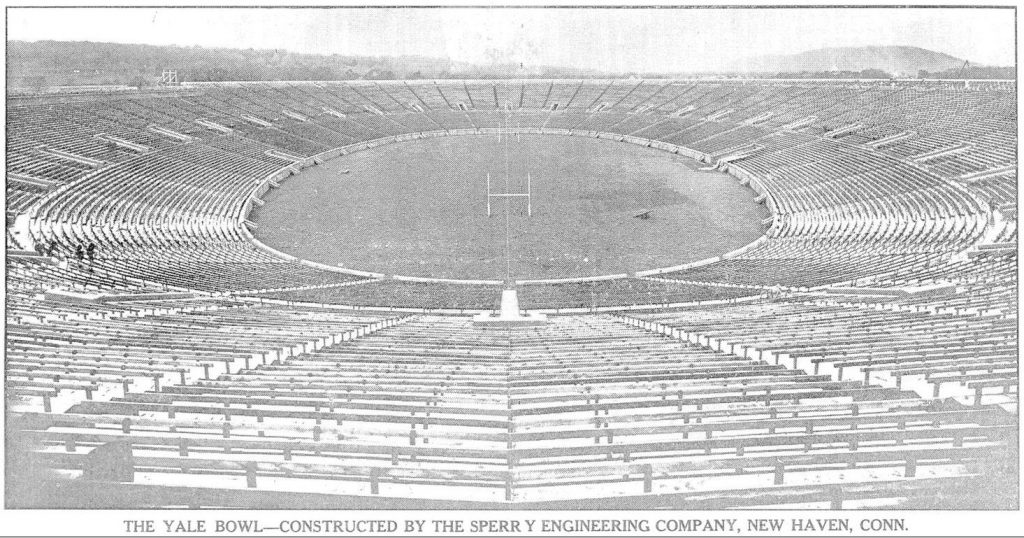
Another Ivy League university, Yale, constructed the first stadium in the United States with a bowl design. Yale Bowl features seating that completely surrounded the playing field below. Inspiration for the Bowl Stadium layout is rooted in the Roman Colosseum and ancient Greek amphitheaters. Architect Charles A. Ferry drew up plans for the Yale Bowl, which opened in 1914.[xvi] The Yale Bowl replaced Yale Field.
Of note is the Yale Bowl’s depressed gridiron. Sperry Engineering Company constructed the bowl stadium by digging a large pit and mounding the excavated earth around it. Then reinforced concrete was applied to produce a continuous ring of seats set on the gentle slope surrounding the playing field. Thirty reinforced concrete tunnels pierce the great mound, providing ingress and egress for fans. This visual experience, as one goes from dark into light and revealing the football gridiron and fan seating, is quite unique to the Yale Bowl. The stadium in New Haven, CT is a designated National Historic Landmark.
The Yale Bowl inspired many bowl stadium designs in the years to come, including The Rose Bowl, Michigan Stadium and Los Angeles Memorial Coliseum.
THE BIRTH OF THE MUNICIPAL STADIUM
Some schools teamed up with their town’s government officials to build municipal stadiums. The municipal stadium served as a site for college and high school football games, while also hosting numerous local events and activities. One of the most notable and earliest municipal stadiums is Tacoma Stadium, now Stadium Bowl, built in 1909-10 in Tacoma, Washington. Architect Frederick Heath designed the stadium into a deep ravine or gulch, with views of Puget Sound. Stadium Bowl is considered one of America’s most beautiful stadium settings and a significant structure in the Stadium-Seminary Historic District, listed on the National Register of Historic Places in 1977. Additionally, Stadium Bowl is historically and architecturally significant as an example of natural site integration and selection in early American football stadium architecture.
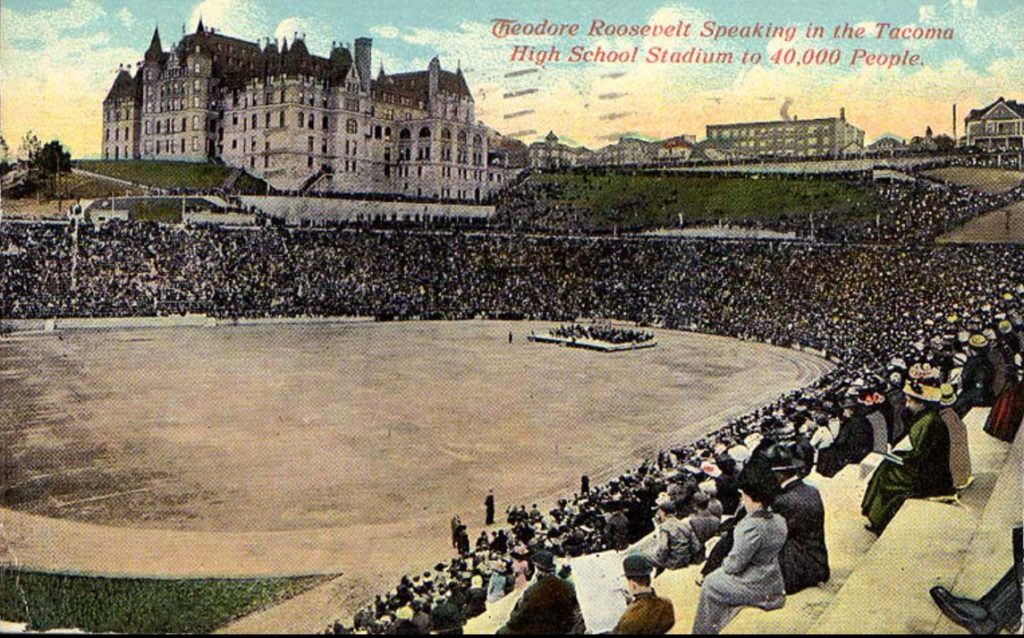
More to come…Next..Part III: THE ARCHITECTURE OF THE AMERICAN FOOTBALL STADIUM (1900-1945)
[i] Danzig, Allison. The History of American Football: Its Great Teams, Players, and Coaches. Englewood Cliffs, NJ: Prentice-Hall, Inc., 1956, p. 7.
[ii] Ibid.
[iii] Ibid, p. 15.
[iv] “Racine vs. University.” The Chronicle, University of Michigan. pp.248-249.
[v] Watterson, John Sayle. College Football: History, Spectacle, Controversy. Boston: Johns Hopkins University Press, 2000, p. 39.
[vi] Danzig, p. 25.
[vii] Danzig, p. 28, 32.
[viii] Danzig, p. 29.
[ix] Ibid, p. 31.
[x] Danzig, p. 19.
[xi] “Franklin Field Was Formally Opened at 1895 Relay Carnival.” The Pennsylvanian. Thursday, November 26, 1925. Vol. XLII, No. 54, pp. 1, 10.
[xii] “Began Wrecking Old Franklin Field Stands.” The Pennsylvanian. Philadelphia, PA. May 1, 1922, p. 1.
[xiii] “The New Stadium for Syracuse University.” Architects’ and Builders’ Magazine. Vol.9, No.7, April 1908, pp. 311.
[xiv] Soldier Field Athletic Area, Harvard University. Accessed at https://sah-archipedia.org/buildings/MA-01-AB9 on February 16, 2023.
[xv] Harvard Stadium. National Register of Historic Places Registration Form, p. 141.
[xvi] The Yale Bowl. National Register of Historic Places Registration Form, p. 2.
